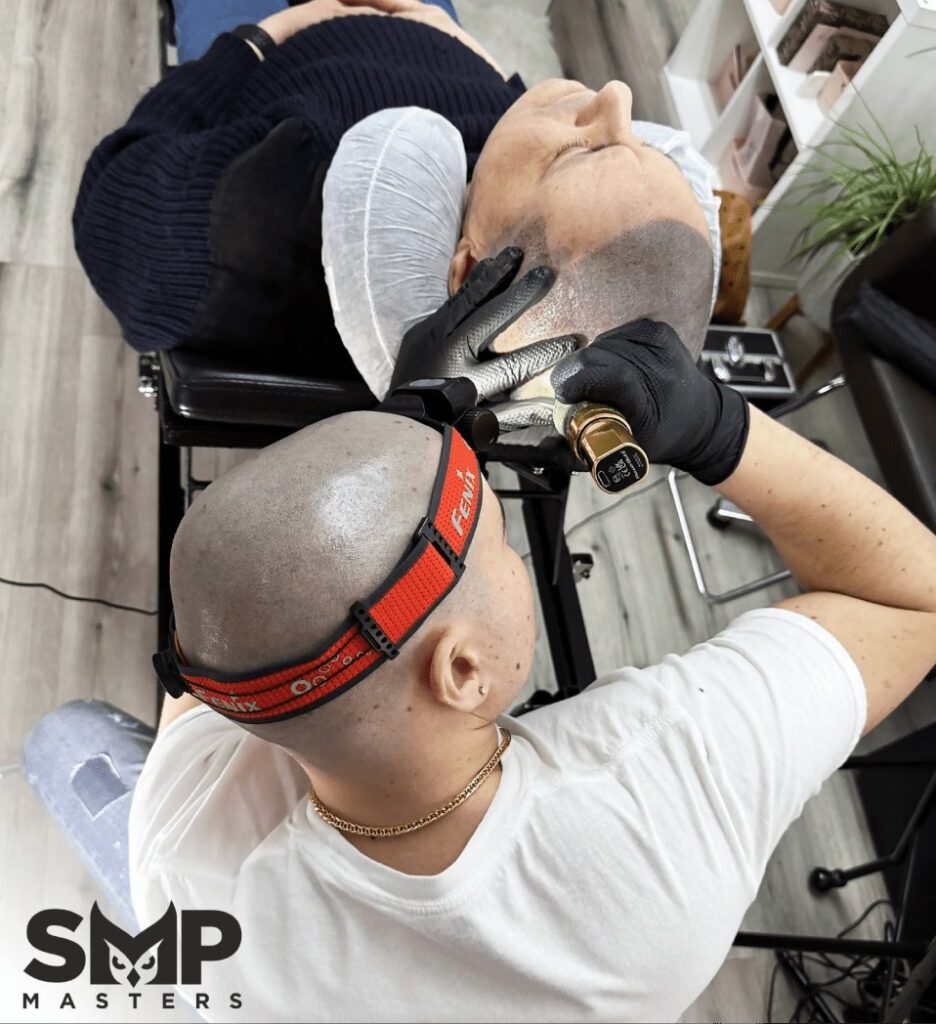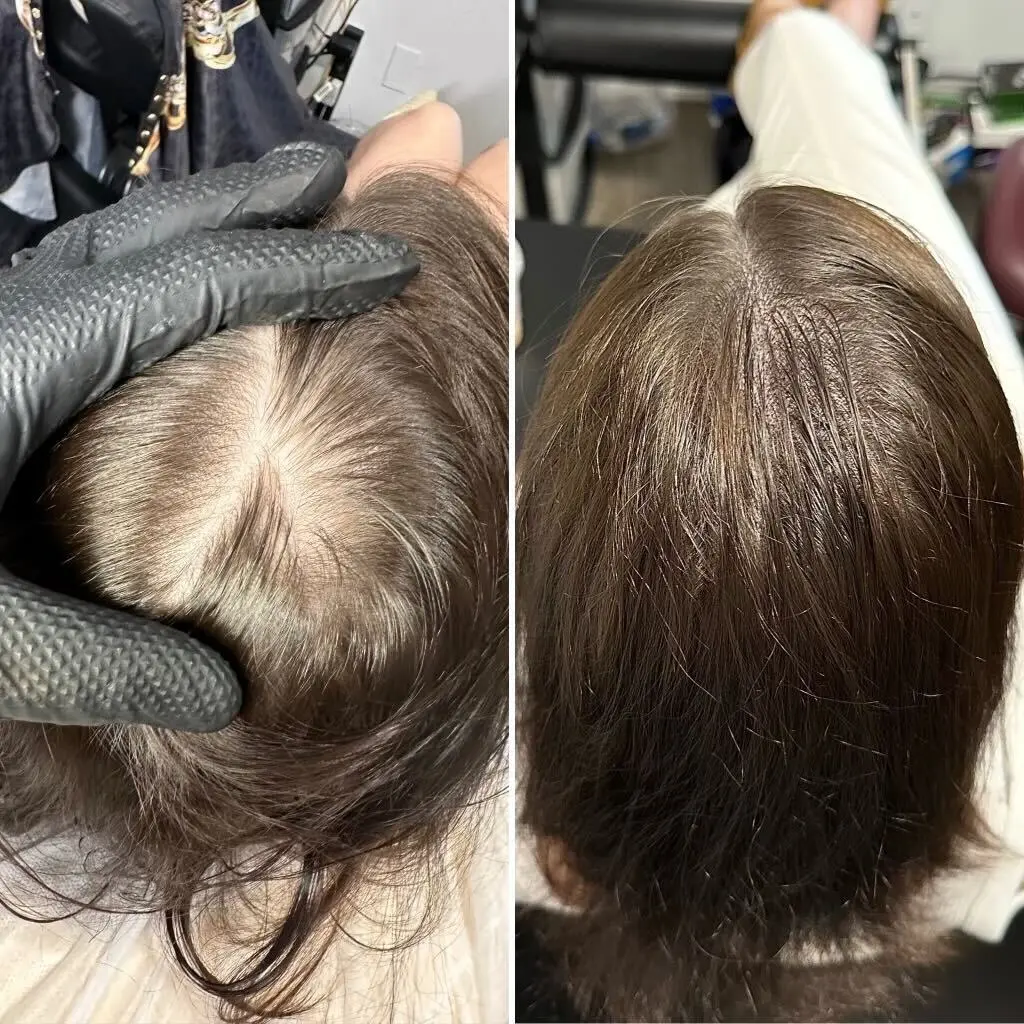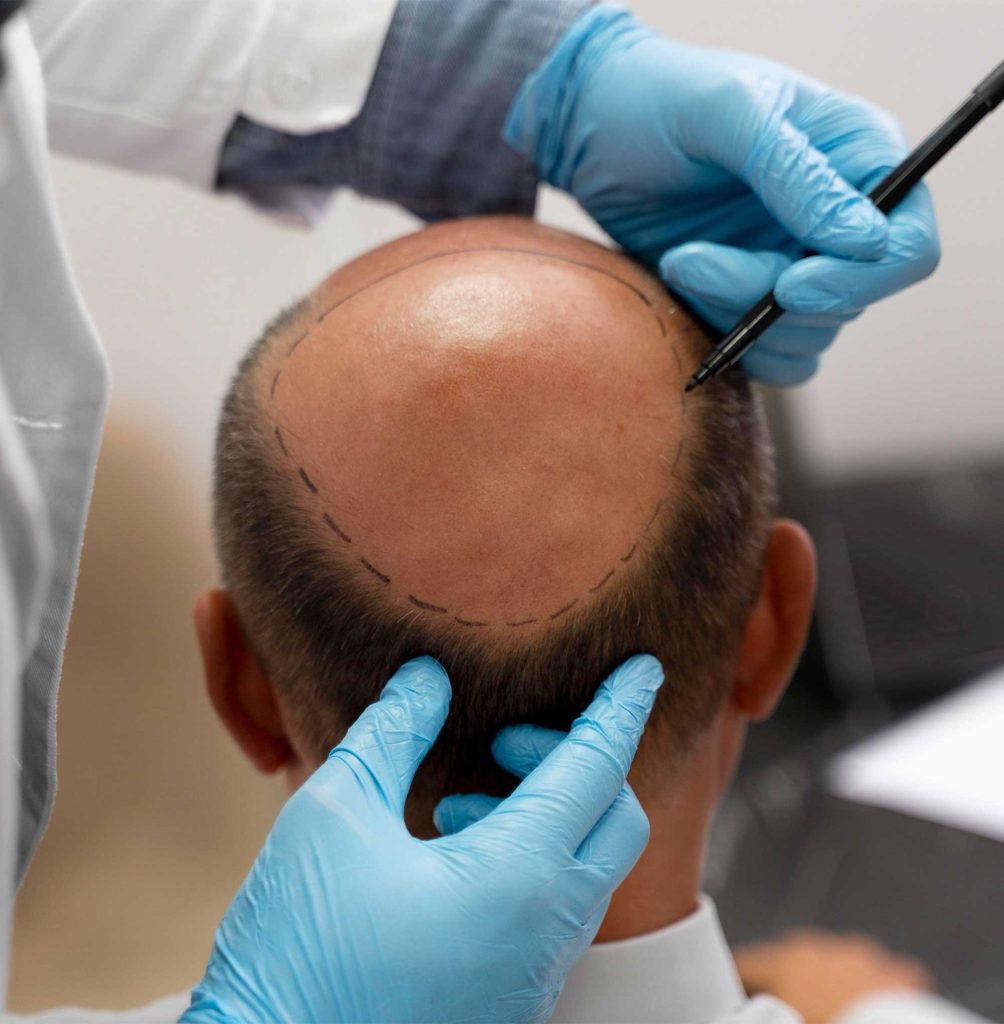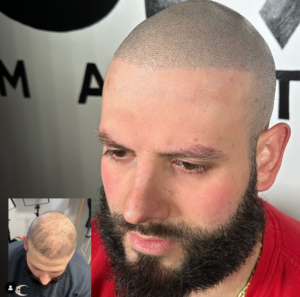Micro Scalp Pigmentation Near Me Care and Maintenance Tips is essential reading for anyone considering or currently maintaining scalp micropigmentation. At SMP Masters | Scalp Micropigmentation | SMP Artist | SMP Clinic, we understand the importance of not just providing top-tier SMP services, but also ensuring that our clients are equipped with the knowledge to care for their new look. Scalp micropigmentation is a transformative procedure, and proper aftercare is crucial to maintain the aesthetic and health of your scalp. In this introduction, we’ll guide you through key tips and practices to help you preserve the sharp, confident appearance that SMP offers. Whether you’re newly treated or simply looking to keep your micropigmentation looking its best, our expert advice will serve you well.
Scalp Micropigmentation (SMP)
Scalp Micropigmentation (SMP) is a non-invasive procedure where micro-needles deposit pigment into the scalp, simulating tiny hair follicles. This technique enhances the appearance of a fuller hairline and denser hair, making it ideal for those with thinning hair, receding hairlines, or bald spots. It also conceals scalp scars and other imperfections. SMP offers a low-maintenance, reliable alternative to traditional hair restoration methods, providing natural-looking results that boost confidence and improve appearance.

What is SMP Treatment?
Scalp Micropigmentation (SMP) is a revolutionary cosmetic procedure that enhances the appearance of the scalp by creating the illusion of hair. Here are the key points:
- Non-Invasive Technique: Utilizes micro-needles to deposit natural pigments into the scalp, mimicking tiny hair follicles or short hair stubble.
- Appearance Enhancement: Ideal for creating a fuller look in areas with thinning hair, receding hairlines, or bald patches.
- Scalp Concealment: Effectively covers scars and imperfections on the scalp from previous injuries or surgeries.
- Customizable: Tailored to match individual hair color and skin tone for a natural and seamless look.
- Long-Lasting Results: Provides a durable solution with minimal maintenance required; results can last for several years.
- Non-Surgical Alternative: A preferred option for those seeking a less invasive solution compared to traditional hair restoration methods.
This detailed approach ensures clients are well-informed about the benefits and process of SMP treatment.
Who is a Good Candidate for SMP?
Scalp Micropigmentation (SMP) is a versatile treatment that offers a solution for a variety of hair loss issues. It is not limited to a specific gender or age group, making it an excellent option for anyone looking to improve the appearance of their scalp. SMP creates a realistic hair follicle look, which can enhance confidence and self-perception. Here’s a closer look at who might benefit from SMP:
- Individuals with Complete Baldness: For those who have lost all their hair or prefer a fully shaven look, SMP can create a uniform, clean-shaven appearance across the entire scalp.
- People with Thinning Hair: SMP is effective in reducing the visible contrast between hair and scalp in lighter-skinned individuals, giving the illusion of denser hair and fuller coverage.
- Areas with Patchy Hair Loss: Suitable for covering patches where hair is missing due to conditions like alopecia areata, SMP helps integrate these areas seamlessly with existing hair, especially when the surrounding hair is kept short.
- Scar Concealment: For individuals with scars from surgeries, injuries, or previous hair transplants, SMP can effectively camouflage these areas, integrating them with the hair pattern.
Scalp Micropigmentation provides a cosmetic alternative to traditional hair restoration methods, offering a non-invasive, immediate improvement in the hair’s appearance. It is an empowering option for those who wish to redefine how they deal with hair loss. To explore whether SMP is right for you, consider scheduling a consultation with a specialized provider in this field.
How Is Scalp Micropigmentation Done?
Scalp Micropigmentation (SMP) is a detailed and precise procedure that involves several key components to achieve the appearance of natural hair follicles on the scalp. Here’s an overview of how SMP is performed, using the specified components:
SMP Ink (Pigment)
The pigment used in SMP is specifically designed for the procedure. It is formulated to match the natural hair color and skin tone of the client, ensuring a realistic and subtle result. Unlike traditional tattoo inks, SMP pigments are less prone to discoloration over time and are deposited at a shallower depth in the skin.
SMP Needle
The needle used in SMP is much finer than those used in regular tattoos. It is designed to replicate the size and shape of a hair follicle, allowing for precise placement and minimal invasiveness. The unique size and design of the SMP needle help in creating the look of natural hair stubble.
SMP Handpiece Machine
The handpiece machine used in SMP is a specialized tool that helps control the depth and pressure of the needle. This precision is crucial for ensuring that the pigment is evenly distributed and that each dot is consistent with the others. The machine’s design allows for enhanced control and maneuverability, essential for achieving a natural-looking hairline and filling in larger areas uniformly.
SMP Sessions
Scalp Micropigmentation is typically completed over several sessions, with each session lasting about 2 to 4 hours. The number of sessions needed can vary based on the extent of hair loss, the size of the area to be covered, and the desired density. Sessions are spaced about 10 to 14 days apart to allow for healing and the settling of pigments. During each session, layers of pigment dots are carefully applied, building up the density and shade gradually to create a more natural and three-dimensional appearance.
Each session and step in the SMP process is crucial for achieving the best results. The gradual layering and careful matching of pigments ensure a realistic outcome that enhances the client’s features and meets their expectations.
How to Prepare for Scalp Micropigmentation?
To prepare for Scalp Micropigmentation (SMP), consider these streamlined steps:
- Consultation: Discuss your goals and concerns with an SMP specialist.
- Scalp Care: Avoid sunburn and chemical treatments on your scalp.
- Hydration: Drink plenty of water to keep your skin healthy.
- Haircut: Trim or shave your hair as advised by your practitioner.
- Avoid Blood Thinners: Steer clear of alcohol, caffeine, and certain medications a week prior (check with your doctor).
- Rest: Ensure a good night’s sleep before your session.
These preparations will help ensure an effective and smooth SMP procedure.
What to Expect on the Day of the Procedure?
- On the day of your Scalp Micropigmentation (SMP) procedure, the experience is designed to be smooth and straightforward. When you arrive at the clinic, you’ll have a bit of time to settle in and get comfortable. The specialist will then thoroughly clean your scalp to ensure it’s free of oils, setting the stage for optimal pigment application.
- A topical anesthetic might be applied to minimize any discomfort, although the procedure is generally low in pain. The application of the pigment is a precise process, with the practitioner using a specialized SMP machine to inject the pigment into the scalp, meticulously crafting the appearance of natural hair follicles.
- The procedure itself can last between 2 to 4 hours, based on how much area needs to be covered. You might have short breaks during the session to stretch and relax. This meticulous approach helps ensure that you receive the most natural-looking results possible.

What Is the Recovery From Scalp Micropigmentation?
Recovery from Scalp Micropigmentation (SMP) is relatively straightforward and involves minimal downtime, allowing most individuals to return to their daily activities fairly quickly. Here’s what you can typically expect during the recovery phase:
- Immediate Aftercare: Right after the procedure, you may notice some redness and slight swelling on the scalp. This is normal and usually subsides within a few days.
- Healing Process: The scalp may feel tender during the first few days, and you might see tiny scabs forming where the pigment was applied. It’s important not to pick at these scabs as they naturally flake off, ensuring the pigment sets properly.
- Avoiding Water and Sun: For the first 4-5 days post-procedure, keep the treated area dry and avoid washing your hair or engaging in activities that cause excessive sweating. Also, stay out of direct sunlight or use a hat to protect the scalp from UV rays, which can fade the pigment.
- Moisturizing: After the initial few days, you can start applying a moisturizer to the scalp to keep the skin soft and aid in the healing process. Use a gentle, fragrance-free product recommended by your practitioner.
- Follow-up Sessions: SMP typically requires multiple sessions to achieve the desired density and shade. These sessions are usually spaced about 10-14 days apart to allow for proper healing between appointments.
- Long-Term Care: To maintain the look, avoid prolonged exposure to sunlight and consider using sunscreen specifically designed for the scalp. Over time, touch-up sessions might be necessary as the pigment can gradually fade.
The overall recovery from SMP is generally uncomplicated, with most people experiencing minimal disruption to their daily routines. With proper care, the results can last for years, providing a durable and natural-looking solution to hair loss.
Is Scalp Micropigmentation Permanent?
Scalp Micropigmentation (SMP) is considered semi-permanent. While the effects can last for several years, they are not entirely permanent like traditional tattoos. The pigments used in SMP are designed to fade gradually over time, which allows for adjustments in style or color as your natural hair color changes or as you age. Typically, SMP can maintain its appearance for 4 to 6 years before a touch-up might be necessary to refresh the color and detail.
What Are the Risks and Complications of Scalp Micropigmentation?
Although SMP is generally safe, as with any cosmetic procedure, there are potential risks and complications involved:
- Mild Discomfort: While SMP is less painful than traditional tattooing, some clients may experience mild discomfort during the procedure.
- Redness: Immediately following the procedure, there may be temporary redness in the treated area.
- Infection: There is a small risk of infection if aftercare instructions are not properly followed or if the procedure is performed under unsterile conditions.
- Poor Aesthetic Outcome: Issues such as color mismatch, color change over time, quick fading, or poor design can occur if the procedure is done by an inexperienced practitioner.
- Allergic Reaction: Although rare, some people may have an allergic reaction to the pigments used.
- Scarring: Improper technique or excessive depth during pigment application can cause scarring.
- MRI Sensitivity: Some pigments may contain metallic elements that could react during an MRI scan, although this is rare with the type of pigments used in most professional SMP procedures.
It’s important to choose a qualified and experienced practitioner for your SMP to minimize these risks. A skilled practitioner will not only perform the procedure safely but also work to achieve the most natural-looking results.
Proper Scalp Hygiene
-
Maintaining cleanliness of the scalp post-procedure is crucial to prevent infection and ensure optimal healing. Gently washing the scalp with mild shampoo and avoiding harsh chemicals helps maintain the integrity of the pigmentation.
Sun Protection
-
Protecting the scalp from the sun is essential after SMP to prevent the fading of pigments. Using a hat or applying a high-SPF sunscreen specifically designed for the scalp can significantly extend the life of SMP results.
Regular Moisturizing
-
Keeping the scalp moisturized after SMP helps soothe the skin and reduce flakiness, which can affect the appearance of the pigmentation. Using fragrance-free, gentle moisturizers recommended by SMP professionals ensures better care.
Follow-Up Care
-
Regular check-ups with your SMP clinic, such as SMP Masters, ensure that any adjustments needed can be addressed promptly. These follow-ups are key to maintaining the look and making timely corrections if there are any color changes or touch-ups needed.
Conclusion
In conclusion, proper scalp care after micro scalp pigmentation is vital for maintaining the crisp, aesthetic look of your treatment. Following the right care and maintenance tips ensures that your “Micro Scalp Pigmentation Near Me” results stay vibrant and natural for years. At SMP Masters Scalp Micropigmentation Clinic, we provide top-notch SMP services and detailed aftercare instructions. It’s important to keep the scalp clean, protect it from the sun, and adhere to the tailored advice from your SMP specialist. With appropriate care, your SMP treatment will enhance your appearance and confidence well beyond the initial session.




